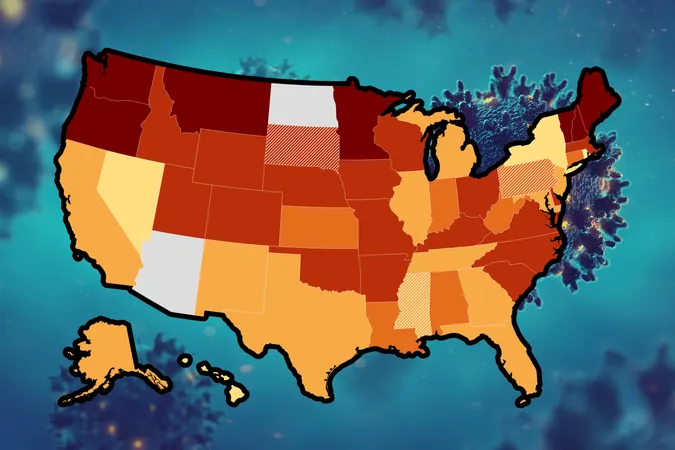
COVID-19 Update: Virus Wastewater Activity Sees an Alarming Shift to the North
2024-10-07
Author: Jia
COVID-19 Wastewater Detection Levels
Recent updates on COVID-19 indicate a worrying trend as wastewater detection levels of the virus remain at "very high" levels in several states, particularly in the Northern regions of the United States. According to the latest data from the U.S. Centers for Disease Control and Prevention (CDC), a notable northward movement in viral activity has been observed, raising concerns among health officials.
Nationwide Viral Activity Improvement
As of September 28, the overall nationwide viral activity in wastewater has improved from "high" to "moderate," but this masks significant variability and localized surges. Seven states continue to report "very high" levels of detection, while 18 states fall under the "high" category. Furthermore, seven states show "moderate" levels, and 12 manage to maintain "low" detection levels. In a positive note, five states, including Washington D.C., have observed "minimal" detection levels, the lowest rank in the CDC’s classification.
Infection Rates and Emerging Variants
After a spike in COVID-19 infections over the summer months, there is a ray of hope as infection rates appear to be on the downturn. As of late September, confirmed cases account for just 11.6% of all tests conducted (excluding at-home tests), a decrease from the previous week's figures. However, the Northern states are seeing concerning levels of COVID activity, prompting calls for vigilance.
Wastewater Analysis Insight
Vital insights can be drawn from wastewater analysis as it serves as a real-time indicator of COVID-19 prevalence in the community. The unfolding scenario is compounded by emerging variants, particularly a new class of subvariants labeled FLiRT, which have adaptations in their spike proteins that may allow them to evade the immune response more effectively. There’s promising news, though, as current vaccines are expected to still offer protection against severe outcomes and long-term effects of COVID-19.
Subvariant Prevalence
Data reveals that the dominant subvariant, KP.3.1.1, is responsible for over 59% of COVID-19 cases reported in the U.S. over the past two weeks, while the FLiRT variants collectively account for over 80%. Encouragingly, even with rising cases, the rates of hospitalizations and fatalities remain subdued, suggesting these variants might lead to milder infections.
Health Precautions and Symptoms
Health experts urge everyone, especially those at higher risk, to remain alert. Common symptoms to watch for include:
- Fever or chills - Cough - Shortness of breath - Fatigue - Muscle or body aches - Headache - Loss of taste or smell - Sore throat - Runny nose - Nausea or vomiting - Diarrhea
As the situation evolves, it’s critical for individuals to take precautions and self-isolate if they test positive. The coming weeks will be crucial in tracking these developments. Stay safe and informed, as the pandemic continues to impact our lives and communities.




 Brasil (PT)
Brasil (PT)
 Canada (EN)
Canada (EN)
 Chile (ES)
Chile (ES)
 España (ES)
España (ES)
 France (FR)
France (FR)
 Hong Kong (EN)
Hong Kong (EN)
 Italia (IT)
Italia (IT)
 日本 (JA)
日本 (JA)
 Magyarország (HU)
Magyarország (HU)
 Norge (NO)
Norge (NO)
 Polska (PL)
Polska (PL)
 Schweiz (DE)
Schweiz (DE)
 Singapore (EN)
Singapore (EN)
 Sverige (SV)
Sverige (SV)
 Suomi (FI)
Suomi (FI)
 Türkiye (TR)
Türkiye (TR)